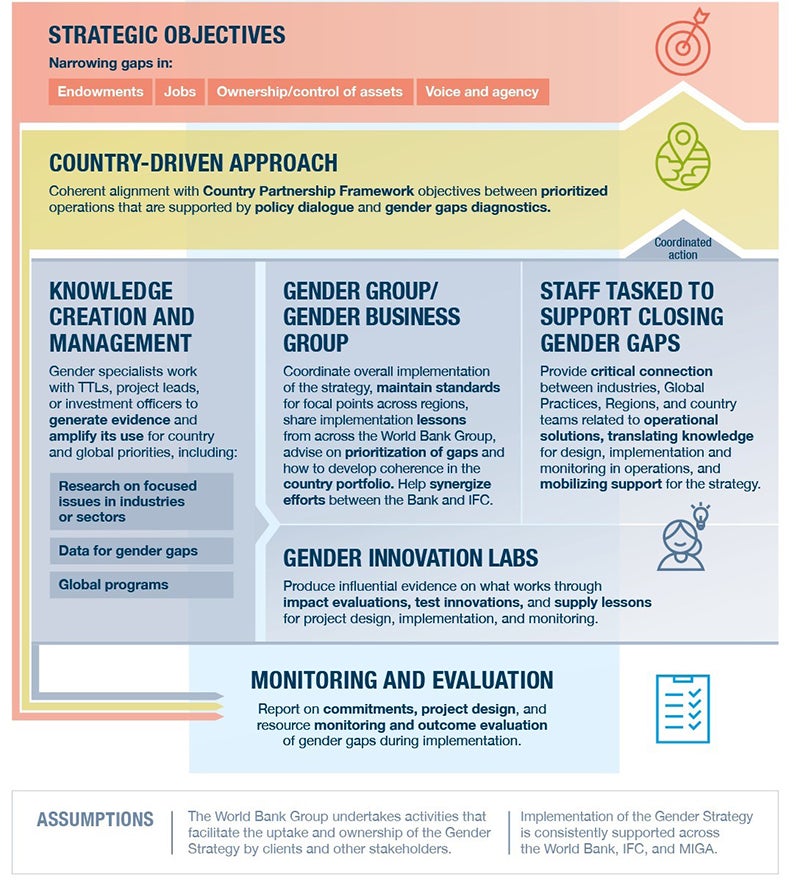Many large development organizations face challenges in implementing a gender strategy. A mid-term review of the World Bank Group’s Gender Strategy uses a theory of action to illustrate the institutional factors that enable implementation.
Recent evaluations in the African Development Bank, Inter-American Development Bank and the World Food Program point to difficulties in helping staff to think and act with a gender lens in their work. Key issues often revolve around who supports staff, how to resource support and what knowledge is required to assist implementation.
The current gender strategy of the World Bank Group has defined the institution’s approach since 2016. At the heart of the Gender Strategy is a move towards the prioritization of gender gaps drawing upon focused analysis, action and measurement. The gender gap approach seeks to address deficits identified in the gender mainstreaming approach (used previously), such as: weaknesses in embedding a gender equality orientation across organizations, fragmented results and low replication of success (UNU-WIDER, 2014: 13).
A recently completed IEG mid-term review of the World Bank Group’s Gender Strategy identifies opportunities to maximize implementation efforts. The review found that commitment to the Gender Strategy by Bank Group management and staff has translated into progress against plans and good practices in implementing the strategy. This commitment is reflected in changes in how organizational goals are framed and in the increased number of projects targeting gender gaps. When support was well defined, resourced, and coordinated, it helped projects address specific gender gaps for agreed priorities.
While commitment at the level of strategy is a prerequisite, actions at the level of the country portfolio and in coordinating support, are also needed. The review found that challenges in implementation arose when there was a lack of support to help identify a gender gap, limited ability to translate technical knowledge into practice, or limited monitoring of gender in projects implementation.
To visualize and discuss needed enhancements we put together what evaluators call a theory of action – a diagram that describes the important elements for implementation, their design and connections. The theory of action identified four interconnected institutional elements and factors that enable the implementation of the strategy: commitment to strategic objectives; prioritizing gaps at a country-level; coordinated support to implementation; and monitoring and evaluation of commitments and projects from design to closure. The diagram below elaborates on these four areas.

Commitment to Strategic Objectives
Maintaining a focus on the strategic objectives requires strong commitment from the management and governance structures of the organization. Buy-in is necessary for successful implementation of the strategy through, for example, creating staff incentives to reinforce the strategy’s aims. Without this commitment gender will not remain in focus and other areas of work will become prioritized. Implementation actions need to consistently match this commitment and be commensurate with the level of ambition in the strategy.
Prioritization of a Country-driven Approach
The gender strategy advances a country-driven approach as a critical pathway to support the closure of gender gaps. In the World Bank Group, a country driven approach is particularly important as country programs form the main unit to define, implement and review progress with national governments. The Gender Strategy highlights that sustained progress to closing gender gaps will accrue through coherent alignment from country objectives to projects, policy dialogue, diagnostics, and monitoring.
Fully addressing gender gaps takes sustained effort, spans multiple projects, and can be addressed more strategically using Bank Group instruments collectively in a country. For example, to enable more women to enter the workplace can require a change in childcare practices, which needs a coherent approach comprising of policy change, training and private sector investments to support countrywide implementation.
Coordinating Support to Implementation
To build on commitment and prioritization a country program needs a range of support. The review noted that implementation of the strategy could be enhanced when four sources of support worked together:
- knowledge generation, curation and use;
- gender groups that maintain standards, advise staff who support implementation of the strategy on the prioritization of gaps and help synergize efforts between different organizational siloes;
- gender specialists, and focal points with contextual and sector know-how who can connect different resources; and
- gender innovation labs to support new influential efforts to address gaps.
The review identified how these four sources enabled or constrained implementation of the strategy. For example, all four play a role in supporting the use of analysis to identify and address gender gaps. Gender groups and Gender Innovation Labs can invest in and champion evidence production, such as, impact evaluations, business cases, and specific studies that can assist project implementation.
Yet, even with these sources of support in place, unless operational staff receive assistance from both gender specialists and focal points, evidence on gender gaps can be difficult to access or be too hard to translate into different contexts.
Monitoring and Evaluation
Cutting across all these areas is the need to monitor and evaluate. Without processes to assess commitments, project design, implementation and outcomes, actions may fail to adapt and attention to gender may weaken. The World Bank has put in place processes to measure progress on closing gender gaps through reporting on both corporate commitments and project design, but less attention to implementation and outcomes.
With good monitoring and evaluation of gender gaps, opportunities for adaptation can be identified and the assessment of outcomes can help direct implementation towards success. For example, through monitoring supported by the Gender Action Learning System, a project in Kenya identified during implementation the need for enhanced targeting of women entrepreneurs. Further, as a result of a range of evaluation activities, a commercially viable and effective technical assistance(?) and training program for women-owned and women-led small and medium enterprises was scaled-up. Together monitoring and evaluation help to maintain focus on priority gaps and help understand if the gaps are closing meaningfully.
Final Thoughts
Ensuring synergies in support helps to overcome implementation bottlenecks. Having well organized support enables actions to be contextualized and focus on prioritized gender gaps. Enhancing internal organizational support models through improved coordination, standards and evidence translation are within the control of development agencies and as review shows, requires continued effort.









Comments
Congratulations to you folks…
Congratulations to you folks! It was really an honor for me to contribute to this project.
All the best, Jana
Thanks Janet. It was a…
Thanks Janet. It was a pleasure and it was great that we could learn from your experience and knowledge.
Add new comment